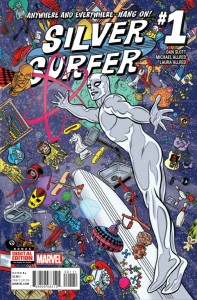 Silver Surfer #1 — Writer: Dan Slott; Art: Michael Allred; Colors: Laura Allred
Silver Surfer #1 — Writer: Dan Slott; Art: Michael Allred; Colors: Laura Allred
Captain Marvel #1 — Writers: Michele Fazekas and Tara Butters; Art: Kris Anka; Colors: Matthew Wilson
Patsy Walker, A.K.A. Hellcat #2 — Writer: Kate Leth; Art: Brittney L. Williams; Colors: Megan Wilson
Ms. Marvel #3 — Writer: G. Willow Wilson; Art: Takeshi Miyazawa; Colors: Ian Herring
Starbrand and Nighthawk #2 — Writer: Greg Weisman; Art: Domo Stanton; Colors: Jordan Boyd
This is another week with a bunch of the “newer” Marvel titles — not so much in numbering, since they’ve all been restarted, but in style: these tend to be brighter and 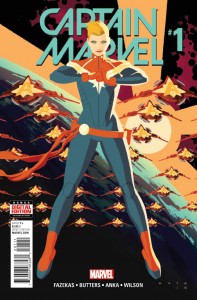 lighter in tone, suitable for all ages (but with sophisticated enough themes and plots for adults, too), and diverse and welcoming enough in their characters to attract a much wider range of readers. None of this would make any difference if the comics were stupid, of course, but they aren’t — there are some great writers and artists creating some amazing books here. Take Silver Surfer #1, for example: a relaunch in name only, since it retains writer Dan Slott and the Michael and Laura Allred art and coloring team. With the previous volume’s romance between the Surfer and plucky all-American girl Dawn Greenwood (who’d be played by Zooey Deschanel in a movie version) established, this issue starts with their return to Earth, where they deal with aliens siphoning off the planet’s culture — all our myths and legends and stories, both ancient and modern. This leads to a fight against the aliens, who’ve been
lighter in tone, suitable for all ages (but with sophisticated enough themes and plots for adults, too), and diverse and welcoming enough in their characters to attract a much wider range of readers. None of this would make any difference if the comics were stupid, of course, but they aren’t — there are some great writers and artists creating some amazing books here. Take Silver Surfer #1, for example: a relaunch in name only, since it retains writer Dan Slott and the Michael and Laura Allred art and coloring team. With the previous volume’s romance between the Surfer and plucky all-American girl Dawn Greenwood (who’d be played by Zooey Deschanel in a movie version) established, this issue starts with their return to Earth, where they deal with aliens siphoning off the planet’s culture — all our myths and legends and stories, both ancient and modern. This leads to a fight against the aliens, who’ve been  transformed into various pop-fictional icons: one dressed like The Shadow, one as Robin Hood, one as the Matt Baker Dr. Who, one as Zorro, etc. It’s a striking, and fun, visual concept, and so is the way the aliens originally vacuum up all the material in the first place, with colors streaming off of paintings, letters flying out of books, etc. Slott’s plot provides Allred exactly the opportunity for psychedelic, catchy visuals that he’s so good at, and the whole book becomes an effective jumping-on point for new readers. So too for Captain Marvel; although it has a brand-new creative team, with big shoes to fill after the departure of writer Kelly Sue DeConnick and artist David Lopez, they deliver admirably: Carol’s got a new job, commanding a defense satellite in near-Earth orbit that’s staffed by Alpha Flight, among others, and has the assignment of protecting Earth from any cosmic or outer-space menaces before they can make
transformed into various pop-fictional icons: one dressed like The Shadow, one as Robin Hood, one as the Matt Baker Dr. Who, one as Zorro, etc. It’s a striking, and fun, visual concept, and so is the way the aliens originally vacuum up all the material in the first place, with colors streaming off of paintings, letters flying out of books, etc. Slott’s plot provides Allred exactly the opportunity for psychedelic, catchy visuals that he’s so good at, and the whole book becomes an effective jumping-on point for new readers. So too for Captain Marvel; although it has a brand-new creative team, with big shoes to fill after the departure of writer Kelly Sue DeConnick and artist David Lopez, they deliver admirably: Carol’s got a new job, commanding a defense satellite in near-Earth orbit that’s staffed by Alpha Flight, among others, and has the assignment of protecting Earth from any cosmic or outer-space menaces before they can make 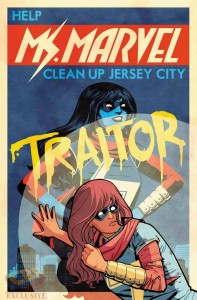 planetfall. This cannily builds on the previous volume’s focus on Carol as a military hero, used to chain-of-command and wargame strategy (but with, somehow, a less testosterone-fueled approach), and her brisk, linear efficiency in dealing with various threats (and wariness of things like meetings or diplomatic subtleties) rings true to the character. Mix in the Kris Anka art, good at the action and with a modern, slightly-manga style for the facial close-ups, and this is another good starting point for newer readers. Of the already-launched series, Hellcat‘s second issue is as bubbly as its first; it’s part Batgirl and part Scott Pilgrim, as Patsy copes with unemployment and tries to figuire out how to start a superhero temp agency stocked with her super-girlfriends: She-Hulk, Squirrel Girl, Valkyrie, Ms. America, Kate Bishop/Hawkeye, and Monica Rambeau/Spectrum. Those are all fun characters, and they’re treated well here, with a balance of humor and adventure that’s just right. Ms. Marvel manages a similar balance — no
planetfall. This cannily builds on the previous volume’s focus on Carol as a military hero, used to chain-of-command and wargame strategy (but with, somehow, a less testosterone-fueled approach), and her brisk, linear efficiency in dealing with various threats (and wariness of things like meetings or diplomatic subtleties) rings true to the character. Mix in the Kris Anka art, good at the action and with a modern, slightly-manga style for the facial close-ups, and this is another good starting point for newer readers. Of the already-launched series, Hellcat‘s second issue is as bubbly as its first; it’s part Batgirl and part Scott Pilgrim, as Patsy copes with unemployment and tries to figuire out how to start a superhero temp agency stocked with her super-girlfriends: She-Hulk, Squirrel Girl, Valkyrie, Ms. America, Kate Bishop/Hawkeye, and Monica Rambeau/Spectrum. Those are all fun characters, and they’re treated well here, with a balance of humor and adventure that’s just right. Ms. Marvel manages a similar balance — no 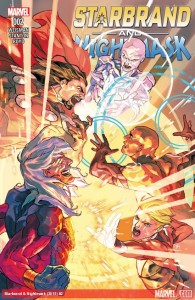 surprise, since it was one of the first comics to prove that readers would be attracted to a seemingly-uncommercial premise (a teen Muslim? Who’s a girl? Who lives in New Jersey? Drawn in a manga style?) as long as it was delivered with wit, compassion and charm. Now that Kamala has a couple of adventures under her belt, and the clueless-rookie phase of her career is ending, her stories look to be getting even better. That leaves Starbrand and Nighthawk; its two unfamiliar leads may put readers off, but its college-roommate/squabbling-bros set-up and mix of cartoony style and traditional supervillain action make it a good companion to the other comics in this group.
surprise, since it was one of the first comics to prove that readers would be attracted to a seemingly-uncommercial premise (a teen Muslim? Who’s a girl? Who lives in New Jersey? Drawn in a manga style?) as long as it was delivered with wit, compassion and charm. Now that Kamala has a couple of adventures under her belt, and the clueless-rookie phase of her career is ending, her stories look to be getting even better. That leaves Starbrand and Nighthawk; its two unfamiliar leads may put readers off, but its college-roommate/squabbling-bros set-up and mix of cartoony style and traditional supervillain action make it a good companion to the other comics in this group.
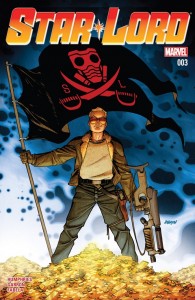 Star Lord #3 — Writer: Sam Humphries; Art: Javier Garron; Colors: Antonio Fabela
Star Lord #3 — Writer: Sam Humphries; Art: Javier Garron; Colors: Antonio Fabela
Uncanny X-Men #2 — Writer: Cullen Bunn; Pencils: Greg Land; Inks: Jayu Leisten; Colors: Nolan Woodard
Two other Marvel books that don’t quite fit the “new” pattern. Star-Lord comes close, especially in Garron’s art (I like Yondu’s combination of con-artist charm and space-pirate menace, and he handles the various alien settings and characters with a light touch; in one scene, Yondu’s breakfast is a can labeled “Beasties,” with 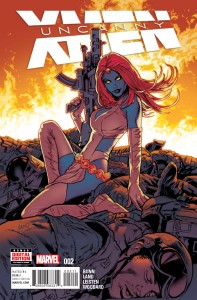 apparently-still-alive shrimp-like contents whose expressions indicate their panic at being skewered with a fork and eaten…), and the character’s origin, after a relatively-slow first couple of issues, ramps up the interest considerably here. Uncanny X-Men is good if you like Greg Land’s art (and the various female characters here play to his strengths), and having them be the sort-of bad-guy team (with Magneto, Mystique, and Sabertooth, especially) gives it some energy, although the plot, involving an attempt to protect mutant healers from a group of mercenaries out to eliminate them, is a little too by-the-numbers to generate much interest.
apparently-still-alive shrimp-like contents whose expressions indicate their panic at being skewered with a fork and eaten…), and the character’s origin, after a relatively-slow first couple of issues, ramps up the interest considerably here. Uncanny X-Men is good if you like Greg Land’s art (and the various female characters here play to his strengths), and having them be the sort-of bad-guy team (with Magneto, Mystique, and Sabertooth, especially) gives it some energy, although the plot, involving an attempt to protect mutant healers from a group of mercenaries out to eliminate them, is a little too by-the-numbers to generate much interest.
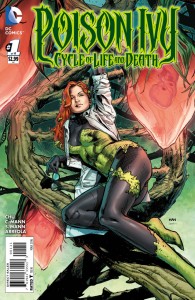 Poison Ivy: Cycle of Life and Death #1 (of 6) — Writer: Amy Chu; Pencils: Clay Mann; Inks: Beth Mann; Colors: Ulises Arreola
Poison Ivy: Cycle of Life and Death #1 (of 6) — Writer: Amy Chu; Pencils: Clay Mann; Inks: Beth Mann; Colors: Ulises Arreola
The Legend of Wonder Woman #1 (of 9) — Writer/Pencils: Renae de Liz; Inks/Colors: Ray Dillon
Superman/Wonder Woman #25 — Writer: Peter Tomasi; Pencils: Doug Mahnke; Inks: Jaime Mendoza, Jonathan Glapion and Scott Hanns; Colors: Wil Quintana
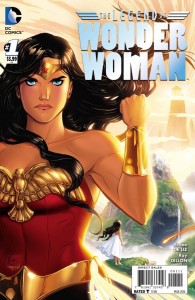 Wonder Woman #48 — Writer: Meredith Finch; Pencils: David Finch; Inks: Scott Hanna; Colors: Brad Anderson
Wonder Woman #48 — Writer: Meredith Finch; Pencils: David Finch; Inks: Scott Hanna; Colors: Brad Anderson
Batgirl #47 — Writers: Cameron Stewart and Brenden Fletcher; Art: Eleonora Carlini and Moritat; Colors: Serge LaPointe
DC’s gotten more female-centric too lately, with Harley Quinn and Batgirl as breakout characters, and more focus on Wonder Woman, as her guest spot in the  Superman/Batman movie (not to mention her own film on the horizon) gives the company more reason to concentrate on her. First this week, though, there’s Poison Ivy, with Pamela Isley as the star of a new mini-series that emphasizes her science/biology side, while also leaving room for a Harley crossover and a murder mystery. That’s paired with three Wonder Woman books; the debut, The Legend of Wonder Woman, is the character’s origin, with a very young Diana on Paradise Island and wanting to be a warrior, not the princess her mother thinks she should be. It’s got good-
Superman/Batman movie (not to mention her own film on the horizon) gives the company more reason to concentrate on her. First this week, though, there’s Poison Ivy, with Pamela Isley as the star of a new mini-series that emphasizes her science/biology side, while also leaving room for a Harley crossover and a murder mystery. That’s paired with three Wonder Woman books; the debut, The Legend of Wonder Woman, is the character’s origin, with a very young Diana on Paradise Island and wanting to be a warrior, not the princess her mother thinks she should be. It’s got good-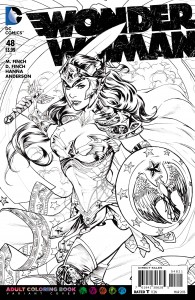 looking art by Renae de Liz (whose style reminds me of Amy Reeder’s), who also supplies the script, thus providing an organic unity between art and story; as a coming-of-age tale, it’s off to a good start. Superman/Wonder Woman involves a still-vastly-depowered Clark Kent, mortally wounded, having to pass a series of tests by the Greek gods before they’ll heal him; it’s a decent stand-alone story, worthy of being an annual, and is one of the DC books with an adult-coloring-book variant this week: a nicely-designed one that combines pinups of the characters with some finely-detailed patterns that should provide a pleasant challenge to all of you colored-pencil or crayon
looking art by Renae de Liz (whose style reminds me of Amy Reeder’s), who also supplies the script, thus providing an organic unity between art and story; as a coming-of-age tale, it’s off to a good start. Superman/Wonder Woman involves a still-vastly-depowered Clark Kent, mortally wounded, having to pass a series of tests by the Greek gods before they’ll heal him; it’s a decent stand-alone story, worthy of being an annual, and is one of the DC books with an adult-coloring-book variant this week: a nicely-designed one that combines pinups of the characters with some finely-detailed patterns that should provide a pleasant challenge to all of you colored-pencil or crayon 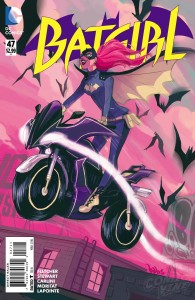 enthusiasts. Wonder Woman #48 has a coloring variant, too — its only real selling point for me, since the inside story, the origin of a new female terrorist/scientist/poison specialist, isn’t particularly special, the kind of thing that George Perez would have knocked out on an off-day during his late-’80s run on the book. That leaves Batgirl, which, like Ms. Marvel, has been an unexpected success; the plot, which involves Barbara, Spoiler, Bluebird and Frankie breaking into the Gotham City Police Department, is fine, but the book suffers from the lack of Babs Tarr art (she’s been a big part of creating the comic’s unique tone), and the clash of styles caused by having different pages drawn by two different artists (although Moritat does a surprisingly-good job aping her animated style during the actual break-in caper sequence).
enthusiasts. Wonder Woman #48 has a coloring variant, too — its only real selling point for me, since the inside story, the origin of a new female terrorist/scientist/poison specialist, isn’t particularly special, the kind of thing that George Perez would have knocked out on an off-day during his late-’80s run on the book. That leaves Batgirl, which, like Ms. Marvel, has been an unexpected success; the plot, which involves Barbara, Spoiler, Bluebird and Frankie breaking into the Gotham City Police Department, is fine, but the book suffers from the lack of Babs Tarr art (she’s been a big part of creating the comic’s unique tone), and the clash of styles caused by having different pages drawn by two different artists (although Moritat does a surprisingly-good job aping her animated style during the actual break-in caper sequence).
 Batman #48 — Writer: Scott Snyder; Pencils: Greg Capullo; Inks: Danny Miki; Colors: FCO Plascencia
Batman #48 — Writer: Scott Snyder; Pencils: Greg Capullo; Inks: Danny Miki; Colors: FCO Plascencia
Robin, Son of Batman #8 — Writer: Ray Fawkes; Art: Ramon Bachs; Colors: Mat Lopes
A couple of other Bat-books; Batman is hitting the climax of its current arc, with the Mr. Bloom character a giant monster menacing Gotham, and a last-page development that fans should cheer; Robin seems to be a fill-in story, a one-shot tale by a different creative team, and with only slight connection to current  continuity; if you like that modern American/manga hybrid style we’ve been talking about, though, Bachs provides a decent example of it. Both books have adult-coloring-book variants; Batman takes the action-splash route, with Batman, the Joker and a bunch of playing cards to keep colorists busy, while Robin uses a pin-up picture instead, with the challenging detail provided by a number of birds (for completists, Sinestro, Titans Hunt and Martian Manhunter, along with the previously-mentioned Wonder Woman and Superman/Wonder Woman, provided the other colorable covers this week).
continuity; if you like that modern American/manga hybrid style we’ve been talking about, though, Bachs provides a decent example of it. Both books have adult-coloring-book variants; Batman takes the action-splash route, with Batman, the Joker and a bunch of playing cards to keep colorists busy, while Robin uses a pin-up picture instead, with the challenging detail provided by a number of birds (for completists, Sinestro, Titans Hunt and Martian Manhunter, along with the previously-mentioned Wonder Woman and Superman/Wonder Woman, provided the other colorable covers this week).
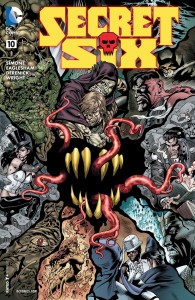 Secret Six #10 — Writer: Gail Simone; Art: Dale Eaglesham and Tom Derenick; Colors: Jason Wright
Secret Six #10 — Writer: Gail Simone; Art: Dale Eaglesham and Tom Derenick; Colors: Jason Wright
Clean Room #4 — Writer: Gail Simone; Art: Jon Davis-Hunt; Colors: Quinton Winter
Lucifer #2 — Writer: Holly Black; Art: Lee Garbett; Colors: Antonio Fabela
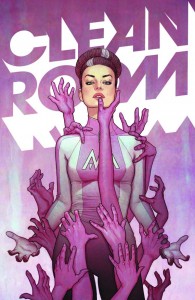 Astro City #31 — Writer: Kurt Busiek; Art: Jesus Merino; Colors: Alex Sinclair
Astro City #31 — Writer: Kurt Busiek; Art: Jesus Merino; Colors: Alex Sinclair
These are DC’s Vertigo titles. sort-of creator owned and therefore more quirky; Secret Six is there because, written by Gail Simone (who also does the truly-disturbing horror book Clean Room, involving a Scientology-ish cult leader who’s either battling demons or 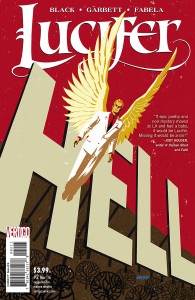 trying to control them, with decidedly mixed results), it has a similar tone, with its oddly-principled semi-bad guys and Simone’s refusal to give anyone a stereotypically-happy ending. Lucifer continues to be OK, more echoing the excellent Mike Carey previous run than matching or topping it, but not embarrassing it either; it misses a bet by not having any
trying to control them, with decidedly mixed results), it has a similar tone, with its oddly-principled semi-bad guys and Simone’s refusal to give anyone a stereotypically-happy ending. Lucifer continues to be OK, more echoing the excellent Mike Carey previous run than matching or topping it, but not embarrassing it either; it misses a bet by not having any 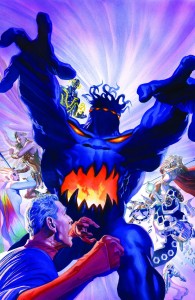 scenes with Morningstar in his nightclub, since that’s what fans of the new TV series are most intrigued by, but having Lucifer and the angel Gabriel as bickering brothers investigating the seeming death of their father, trudging through hell and other bad places, is a solid premise. Astro City is a one-off, with guest artist Merino, about a nightmare demon who slowly finds sentience and purpose (in Busiek’s world, even nightmare demons have relatable emotions, and can receive redemption), and is just as well-told as Astro City always is.
scenes with Morningstar in his nightclub, since that’s what fans of the new TV series are most intrigued by, but having Lucifer and the angel Gabriel as bickering brothers investigating the seeming death of their father, trudging through hell and other bad places, is a solid premise. Astro City is a one-off, with guest artist Merino, about a nightmare demon who slowly finds sentience and purpose (in Busiek’s world, even nightmare demons have relatable emotions, and can receive redemption), and is just as well-told as Astro City always is.
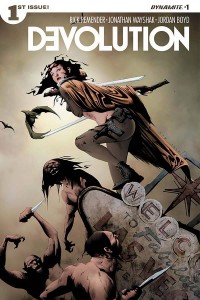 Devolution #1 — Writer: Rick Remender; Art: Jonathan Wayshak; Colors: Jordan Boyd
Devolution #1 — Writer: Rick Remender; Art: Jonathan Wayshak; Colors: Jordan Boyd
American Monster #1 — Writer: Brian Azzarello; Art/Colors: Juan Doe
Amazing Forest #1 — Creators: Various
Man Plus #1 — Writer/Artist/Creator: Andre Lima Araujo; Colors: Arsia Rozegar
Pencil Head #1 — Writer/Artist/Creator: Ted 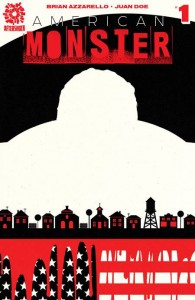 McKeever
McKeever
Five indy first issues — Devolution is the new Rick Remender ongoing series (part of his seeming plan to control the comics industry by writing twenty books a month), and is a Crossed/zombie apocalypse riff, with mankind facing a virus that devolved almost everyone back to caveman, or at least clueless-redneck, status, and a few survivors fighting to produce a cure; Wayshak’s art has a rough-edged underground energy that fits the setting well. American Monster is a Brian Azzarello tough-guy 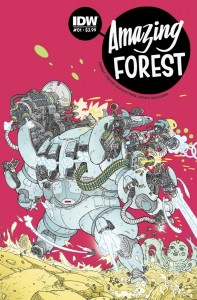 crime book, about a vet returned from the Middle East with his face all burned up, looking like Deadpool; if it’s typical Azzarello, it’ll have some striking individual scenes and pieces of dialogue, and a plot that makes little emotional or logical sense. Amazing Forest is an anthology series: for $3.99, you get four eight-page fantasy/sf stories written by Erick Frietas and Ulises Farinas, with art by various newcomers. There’s a post-apocalyptic alien-invasion tale with art by Julien Dufour (who draws the protagonist as a young Woody Allen); a humans-vs.-werewolves
crime book, about a vet returned from the Middle East with his face all burned up, looking like Deadpool; if it’s typical Azzarello, it’ll have some striking individual scenes and pieces of dialogue, and a plot that makes little emotional or logical sense. Amazing Forest is an anthology series: for $3.99, you get four eight-page fantasy/sf stories written by Erick Frietas and Ulises Farinas, with art by various newcomers. There’s a post-apocalyptic alien-invasion tale with art by Julien Dufour (who draws the protagonist as a young Woody Allen); a humans-vs.-werewolves  one by Matt Rota, with some well-colored expressionistic panels; a story about a rural husband coming home from a cyber/robot war, with a watercolorish Carla Speed McNeil style from Melody Often and an EC-like twist at the end; and one about a birdwatcher obsessed with a new species, with surreal and faux-primitive art from Yumi Sakugawa. It’s sort of like Brandon Graham and Emma Rios’s Island, but with even younger and more rough-hewn creators, and there’s a thrill of discovery in seeing so many different brand-new styles and influences. Next, Man Plus is a Blade Runner-ish urban-future-with-robots story almost entirely by
one by Matt Rota, with some well-colored expressionistic panels; a story about a rural husband coming home from a cyber/robot war, with a watercolorish Carla Speed McNeil style from Melody Often and an EC-like twist at the end; and one about a birdwatcher obsessed with a new species, with surreal and faux-primitive art from Yumi Sakugawa. It’s sort of like Brandon Graham and Emma Rios’s Island, but with even younger and more rough-hewn creators, and there’s a thrill of discovery in seeing so many different brand-new styles and influences. Next, Man Plus is a Blade Runner-ish urban-future-with-robots story almost entirely by 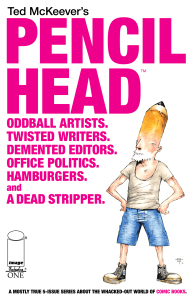 Andre Lima Araujo (everything but the coloring), that wouldn’t be out of place as a serial in Heavy Metal; there are some places near the end that also show a big Katsuhiro Otomo/Akira influence. That leaves Ted McKeever, who’s influenced by no one but himself; Pencil Head #1 did remind me a little of Bob Fingerman’s Minimum Wage (both are about struggling comic-book cartoonists in New York City), although McKeever’s art is a lot more impressionistic than Fingerman’s detailed scruffiness, and the story has more fantasy elements; he’s got a style that readers either immediately love or dismiss, and it’s worth checking out just to see which camp you’re in.
Andre Lima Araujo (everything but the coloring), that wouldn’t be out of place as a serial in Heavy Metal; there are some places near the end that also show a big Katsuhiro Otomo/Akira influence. That leaves Ted McKeever, who’s influenced by no one but himself; Pencil Head #1 did remind me a little of Bob Fingerman’s Minimum Wage (both are about struggling comic-book cartoonists in New York City), although McKeever’s art is a lot more impressionistic than Fingerman’s detailed scruffiness, and the story has more fantasy elements; he’s got a style that readers either immediately love or dismiss, and it’s worth checking out just to see which camp you’re in.
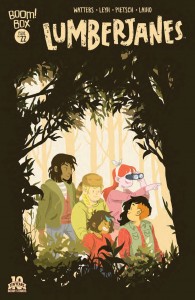 Lumberjanes #22 — Writers: Shannon Waters and Kat Leyh; Art: Carey Pietsch; Colors: Maarta Laiho
Lumberjanes #22 — Writers: Shannon Waters and Kat Leyh; Art: Carey Pietsch; Colors: Maarta Laiho
I Hate Fairyland #4 — Writer/Artist/Creator: Skottie Young; Colors: Jean-Francois Beaulieu
Phonogram: The Immaterial Girl #6 (of 6) — Writer: Kieron Gillen; Art: Jamie McKelvie; Colors: Matthew 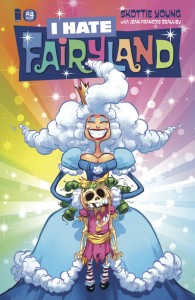 Wilson
Wilson
Rachel Rising #39 — Writer/Artist/Creator: Terry Moore
Usagi Yojimbo #151 — Writer/Artist/Creator: Stan Sakai
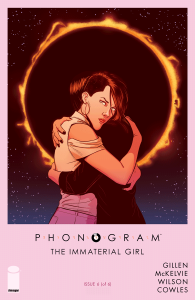 Speaking of camp… Lumberjanes, like Batgirl and Ms. Marvel, is another herald of the kind of comics that readers born in the 21st century find entertaining; that its story of a group of Girl Scouts, set in an enchanted forest and drawn in a TV-animation style, has managed 22 issues and a couple of increasingly-popular trades is a
Speaking of camp… Lumberjanes, like Batgirl and Ms. Marvel, is another herald of the kind of comics that readers born in the 21st century find entertaining; that its story of a group of Girl Scouts, set in an enchanted forest and drawn in a TV-animation style, has managed 22 issues and a couple of increasingly-popular trades is a 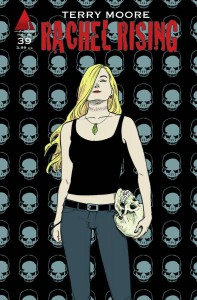 testament to its effectiveness. I Hate Fairyland is its opposite, a cheerfully-cynical in-joke by Skottie Young that revels in cartoon violence and over-the-top bad behavior… by eight-year-old girls. Phonogram: Immaterial Girl, the third volume in a trilogy, concludes its run this week, with an ending that has a
testament to its effectiveness. I Hate Fairyland is its opposite, a cheerfully-cynical in-joke by Skottie Young that revels in cartoon violence and over-the-top bad behavior… by eight-year-old girls. Phonogram: Immaterial Girl, the third volume in a trilogy, concludes its run this week, with an ending that has a 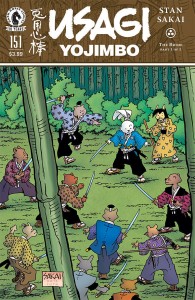 lot more resonance if you’ve read the whole thing; McKelvie’s confident pen lines are sharp enough to draw blood, and Gillen knows just which words to put in the mouths of his stylish, damaged characters. Rachel Rising continues Terry Moore’s engrossing longform (up to 39 issues now) horror story, while Usagi Yojimbo, as usual, has maybe the best done-in-one story of the whole bunch, a well-constructed tale of a forced marriage and multiple murder attempts in Sakai’s perfectly-balanced style.
lot more resonance if you’ve read the whole thing; McKelvie’s confident pen lines are sharp enough to draw blood, and Gillen knows just which words to put in the mouths of his stylish, damaged characters. Rachel Rising continues Terry Moore’s engrossing longform (up to 39 issues now) horror story, while Usagi Yojimbo, as usual, has maybe the best done-in-one story of the whole bunch, a well-constructed tale of a forced marriage and multiple murder attempts in Sakai’s perfectly-balanced style.



